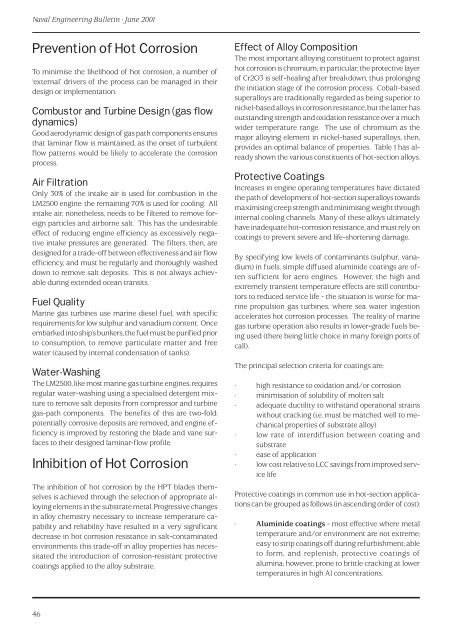Engineering - Royal Australian Navy
Engineering - Royal Australian Navy
Engineering - Royal Australian Navy
You also want an ePaper? Increase the reach of your titles
YUMPU automatically turns print PDFs into web optimized ePapers that Google loves.
Naval <strong>Engineering</strong> Bulletin • June 2001<br />
Prevention of Hot Corrosion<br />
To minimise the likelihood of hot corrosion, a number of<br />
‘external’ drivers of the process can be managed in their<br />
design or implementation.<br />
Combustor and Turbine Design (gas flow<br />
dynamics)<br />
Good aerodynamic design of gas path components ensures<br />
that laminar flow is maintained, as the onset of turbulent<br />
flow patterns would be likely to accelerate the corrosion<br />
process.<br />
Air Filtration<br />
Only 30% of the intake air is used for combustion in the<br />
LM2500 engine: the remaining 70% is used for cooling. All<br />
intake air, nonetheless, needs to be filtered to remove foreign<br />
particles and airborne salt. This has the undesirable<br />
effect of reducing engine efficiency as excessively negative<br />
intake pressures are generated. The filters, then, are<br />
designed for a trade-off between effectiveness and air flow<br />
efficiency, and must be regularly and thoroughly washed<br />
down to remove salt deposits. This is not always achievable<br />
during extended ocean transits.<br />
Fuel Quality<br />
Marine gas turbines use marine diesel fuel, with specific<br />
requirements for low sulphur and vanadium content. Once<br />
embarked into ship’s bunkers, the fuel must be purified prior<br />
to consumption, to remove particulate matter and free<br />
water (caused by internal condensation of tanks).<br />
Water-Washing<br />
The LM2500, like most marine gas turbine engines, requires<br />
regular water-washing using a specialised detergent mixture<br />
to remove salt deposits from compressor and turbine<br />
gas-path components. The benefits of this are two-fold:<br />
potentially corrosive deposits are removed, and engine efficiency<br />
is improved by restoring the blade and vane surfaces<br />
to their designed laminar-flow profile.<br />
Inhibition of Hot Corrosion<br />
The inhibition of hot corrosion by the HPT blades themselves<br />
is achieved through the selection of appropriate alloying<br />
elements in the substrate metal. Progressive changes<br />
in alloy chemistry necessary to increase temperature capability<br />
and reliability have resulted in a very significant<br />
decrease in hot corrosion resistance in salt-contaminated<br />
environments: this trade-off in alloy properties has necessitated<br />
the introduction of corrosion-resistant protective<br />
coatings applied to the alloy substrate.<br />
Effect of Alloy Composition<br />
The most important alloying constituent to protect against<br />
hot corrosion is chromium; in particular, the protective layer<br />
of Cr2O3 is self-healing after breakdown, thus prolonging<br />
the initiation stage of the corrosion process. Cobalt-based<br />
superalloys are traditionally regarded as being superior to<br />
nickel-based alloys in corrosion resistance, but the latter has<br />
outstanding strength and oxidation resistance over a much<br />
wider temperature range. The use of chromium as the<br />
major alloying element in nickel-based superalloys, then,<br />
provides an optimal balance of properties. Table 1 has already<br />
shown the various constituents of hot-section alloys.<br />
Protective Coatings<br />
Increases in engine operating temperatures have dictated<br />
the path of development of hot-section superalloys towards<br />
maximising creep strength and minimising weight through<br />
internal cooling channels. Many of these alloys ultimately<br />
have inadequate hot-corrosion resistance, and must rely on<br />
coatings to prevent severe and life-shortening damage.<br />
By specifying low levels of contaminants (sulphur, vanadium)<br />
in fuels, simple diffused aluminide coatings are often<br />
sufficient for aero engines. However, the high and<br />
extremely transient temperature effects are still contributors<br />
to reduced service life - the situation is worse for marine<br />
propulsion gas turbines, where sea water ingestion<br />
accelerates hot corrosion processes. The reality of marine<br />
gas turbine operation also results in lower-grade fuels being<br />
used (there being little choice in many foreign ports of<br />
call).<br />
The principal selection criteria for coatings are:<br />
• high resistance to oxidation and/or corrosion<br />
• minimisation of solubility of molten salt<br />
• adequate ductility to withstand operational strains<br />
without cracking (i.e. must be matched well to mechanical<br />
properties of substrate alloy)<br />
• low rate of interdiffusion between coating and<br />
substrate<br />
• ease of application<br />
• low cost relative to LCC savings from improved service<br />
life<br />
Protective coatings in common use in hot-section applications<br />
can be grouped as follows (in ascending order of cost):<br />
• Aluminide coatings - most effective where metal<br />
temperature and/or environment are not extreme;<br />
easy to strip coatings off during refurbishment; able<br />
to form, and replenish, protective coatings of<br />
alumina; however, prone to brittle cracking at lower<br />
temperatures in high Al concentrations.<br />
46
















